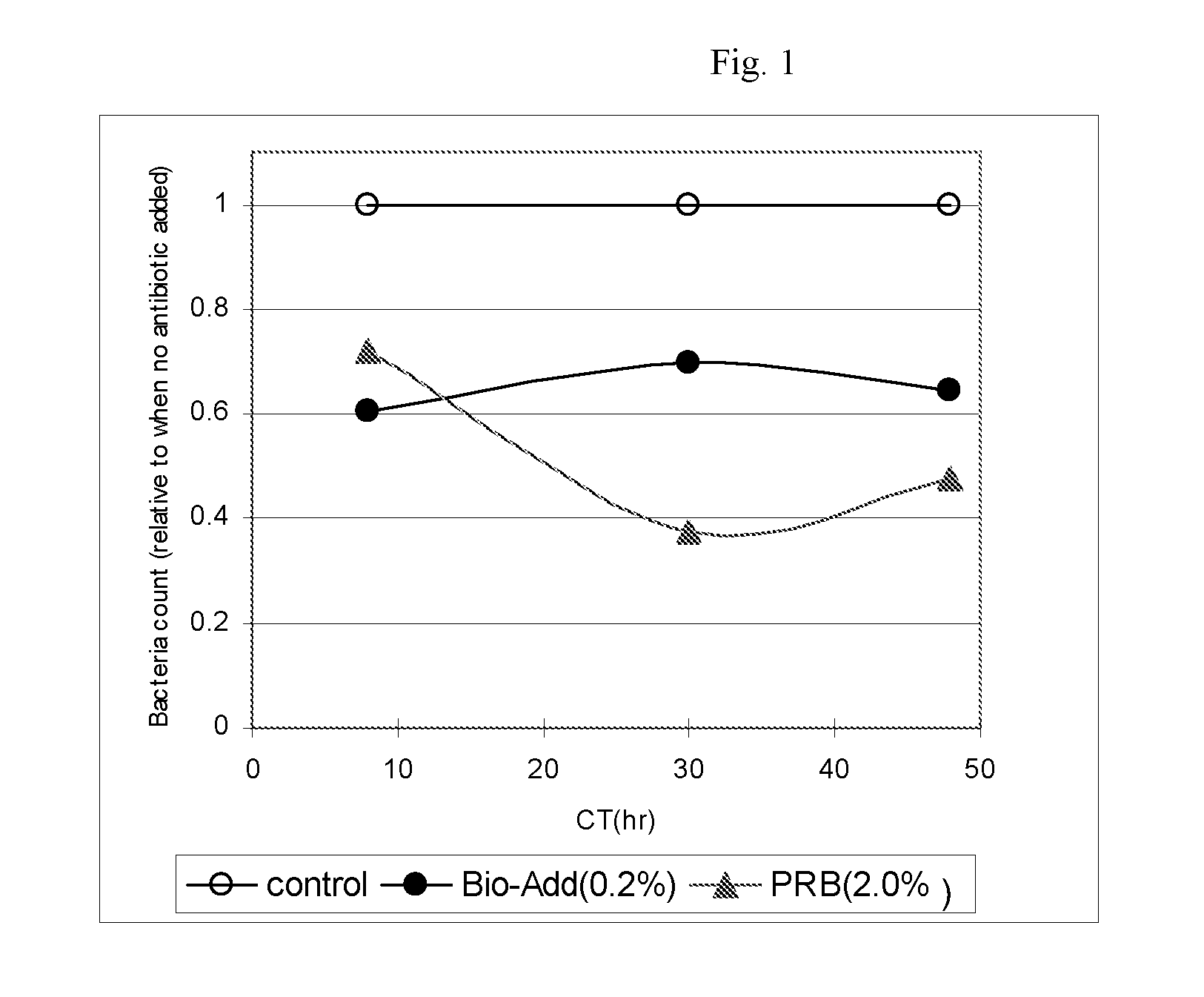Antibiotic, Compositions Containing the Antibiotic, and Methods for Administering the Antibiotic and/or Said Compositions to Livestock
a technology of compositions and antibiotics, applied in the field of compositions containing antibiotics, can solve the problems of adhesion and infection, degraded mannose, and no method has been able to prevent human infection via food poisoning, and achieve the effect of preventing growth
- Summary
- Abstract
- Description
- Claims
- Application Information
AI Technical Summary
Benefits of technology
Problems solved by technology
Method used
Image
Examples
reference example 1
[0044] The method of screening lactic acid bacteria that produce protease-resistant bacteriocin will be described based on the example of separation from the fermented food matsoon.
[0045] To separate the lactic acid bacteria, 0.5 percent of fermented milk matsoon (a type of fermented food) samples were added to a liquid media which permits the growth of lactic acid bacteria, such as MRS medium (Table 1 below) and M17 medium (Table 2 below. The samples were cultured at 30 to 37° C. (preculturing). Culturing was conducted for one, five, or ten days, respectively. Upon completion of culturing, the bacteria were cultured on the above-described agar (1.2 percent) medium containing 0.5 percent calcium carbonate and the lactic acid bacteria colonies that grew were collected.
TABLE 1MRS medium composition (Merck)Peptone10.0g / LLab-Lemco' Powder8.0g / LYeast extract4.0g / LGlucose20.0g / LTween 801.0g / LDipotassium hydrogenphosphate(KH2PO4)2.0g / LSodium acetate5.0g / LAmmonium citrate2.0g / LMagnesium ...
example 1
[0061] The lactic acid bacterium Weissella sp. AJ110263 (FERM P-19577), isolated from fermented milk matsoon, and the lactic acid bacteria Pediococcus pentosaceus JCM5885, Pediococcus pentosaceus JCM5890, Lactobacillus plantarum JCM1149, and Lactobacillus salivarius JCM1231, obtained from type cultures, were precultured and cultured on MRS liquid medium (Table 1 above). The culture temperature was 30° C. for Weissella sp. and 37° C. for the other strains. The above lactic acid bacteria were inoculated onto and cultured for 24 hours on MRS agar medium plates to which “Umamizyme G”, a protease derived from Aspergillus, had been added in quantities of 0 U / mL (none added), 200 U / ML, and 400 U / mL. In culturing, 100 mL of MRS medium was added to a 500 mL Sakaguchi flask, 100 mL of the above culture solution was inoculated, and the medium was shaken 100 times / min.
[0062] Next, Lactobacillus sakei strain JCM1157, which does not produce bacteriocin, was employed as an indicator strain, and L...
example 2
[0063]Lactococcus lactis NCD0497 (a bacterium producing nisin A) and Lactococcus lactis NCIMB702054 (a bacterium producing nisin Z) were separately cultured in MRS liquid medium at 30° C. In the same manner as in Example 1, antibiotic evaluation was conducted using Lactobacillus sakei strain JCM1157 as an indicator strain. Instead of nisin-producing bacterial strains, 10 μL of “nisin A 1,000 IU / mL solution” made by ICN Biomedical was spotted on MRS agar medium plates and the above antibiotic evaluation was conducted (without using bacterial strains).
[0064] Although indicator strains growth inhibition zones formed in the absence of protease, antibiotic activity due to nisin decreased as the protease concentration rose (see Table 11).
TABLE 11protease (U / mL)Strain0200400Nisin A added (not containing any bacteria30NDNDproducing bacteriocin)Lactococcus lactis NCD0497 (a bacterium3013NDproducing nisin A)Lactococcus lactis NCIMB702054 (a3013NDbacterium producing nisin Z)
Lactobacillus sa...
PUM
| Property | Measurement | Unit |
|---|---|---|
| Temperature | aaaaa | aaaaa |
| Temperature | aaaaa | aaaaa |
| Volume | aaaaa | aaaaa |
Abstract
Description
Claims
Application Information
 Login to View More
Login to View More - R&D
- Intellectual Property
- Life Sciences
- Materials
- Tech Scout
- Unparalleled Data Quality
- Higher Quality Content
- 60% Fewer Hallucinations
Browse by: Latest US Patents, China's latest patents, Technical Efficacy Thesaurus, Application Domain, Technology Topic, Popular Technical Reports.
© 2025 PatSnap. All rights reserved.Legal|Privacy policy|Modern Slavery Act Transparency Statement|Sitemap|About US| Contact US: help@patsnap.com

